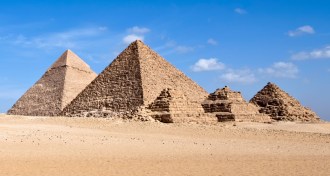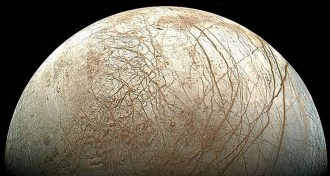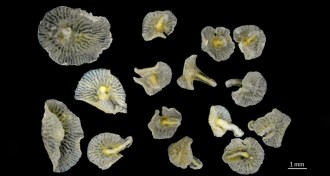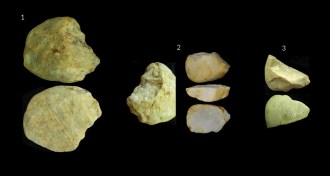Uncategorized
-
 Health & Medicine
Health & MedicineViruses can zoom through workplaces in hours
A virus on an office door handle can spread to more than half the people working there within a few hours.
By Nathan Seppa -
 Health & Medicine
Health & MedicineInjectable flu drug could add to weapons against infection
The experimental drug, given in a single shot, could prove useful in the event of a lethal flu pandemic.
By Nathan Seppa -
 Archaeology
ArchaeologyPyramid builders could have used rolling blocks
Instead of sliding blocks on a ramp, ancient Egyptians could have rolled the massive bricks to the pyramids, a physicist suggests.
By Meghan Rosen -
 Health & Medicine
Health & MedicineAutism treatment for babies shows promise in small study
A small study finds that changing how parents interact with infants may reduce autism symptoms.
-
 Planetary Science
Planetary SciencePlate tectonics spotted on Europa
First evidence for plate tectonics elsewhere in solar system discovered on Jupiter’s icy moon Europa.
-
 Animals
AnimalsMystery mushroomlike sea creatures get names
Specimens of a mushroomlike animal from the sea now have a scientific name, but researchers aren’t sure what kind of animal they are.
By Susan Milius -
 Archaeology
ArchaeologyMore signs emerge of New World settlers before 20,000 years ago
Controversial stone tools of pre-Clovis humans have been excavated in South America.
By Bruce Bower -
 Tech
Tech‘Virtual Unreality’ chronicles dangers of digital deception
Journalist Charles Seife documents how the lies and misinformation that riddle the Internet are harming the real world.
By Janet Raloff -
 Health & Medicine
Health & MedicineTwo-part vaccine protects monkeys from Ebola
An experimental vaccine protected macaques from infection with the Ebola virus up to 10 months after receiving the two-shot regimen.
By Nathan Seppa -
 Genetics
GeneticsMolecular biologist honors ancient bones
After deciphering an ancient skeleton’s genetic secrets, molecular biologist Sarah Anzick helped reinter the remains.
-
 Paleontology
Paleontology‘Dinosaur 13’ details custody battle for largest T. rex
Documentary details nasty custody battle over the dinosaur nicknamed Sue, the largest T. rex skeleton ever found.
By Meghan Rosen -
 Astronomy
AstronomyPlasma corkscrews form on sun during stellar eruption
Coronal mass ejection creates twisted loop in sun’s magnetic field.